HP Z27q Monitor Review: Aiming For More Pixels
by Brett Howse on December 22, 2015 8:00 AM ESTAdobeRGB Calibration
AdobeRGB tests are done with the same workflow as sRGB, but with the target gamut set to AdobeRGB. As with the sRGB, precalibration results are done for 200 nits, and then calibrated results are done for 200 and 80 nits.
Grayscale
Set to AdobeRGB, the pre-calibration results are quite a bit improved over the sRGB values. They are so good that there is actually little reason to calibrate this display if you are using it for AdobeRGB. The average error rate on grayscale is only 1.08, and the gamma curve is almost perfect. The white point is very close to correct as well.
Saturation
Saturations are very good again, with an average error of just 0.5. This is a great result for an uncalibrated display, and you can see that it easily covers the much wider gamut of AdobeRGB here.
GMB
I feel like a broken record a bit, but the pre-calibration results for GMB are fantastic, with an average error of just 0.462. HP has done a fantastic job on the AdobeRGB LUT for this display.
200 cd/m2 Calibrated
Since the pre-calibration measurements were so good, there would be very little if any need to calibrate this display, but for completeness that has been done.
Grayscale
Although the couple of spikes for grayscale have been corrected, the overall result is actually slightly worse than out of the box. The gamma jumps up, and the white point is off. The results were better before, so if I was using this I would throw this out and leave it at stock.
Saturation
With the white point slightly moved, the overall error rate has actually gone up. It’s still excellent, but not as excellent as before.
GMB
The final test also has a higher score, which at 0.67 is still excellent, but the calibration did nothing to help this display on AdobeRGB gamut. Let’s see how it does at 80 nits.
80 cd/m2 Calibrated
Setting the display to 80 nits, it was then calibrated again.
Grayscale
Overall the result is very good again, although the gamma is not as flat as it was before calibration. The white point and average error rate are both very good though.
Saturation
Much like at 200 nits, the pre-calibration measurements are actually better again, but the end result even with the slightly worse scores is still a very accurate representation of the AdobeRGB color space.
GMB
A result of 0.96 is very good, and the Z27q pretty much had no issues with any of the colors in our Gretag Macbeth test.
Relative Color Comparator - Displayed color on bottom, correct color on top
The results from AdobeRGB are even more impressive than the sRGB space. The Z27q can easily hit pretty much 100% of this target gamut, and the built in LUT is incredibly accurate when targeting AdobeRGB. This is one of the rare times were calibration pretty much did nothing.


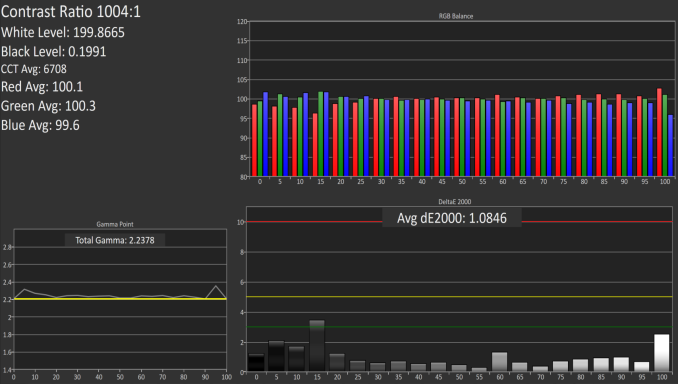
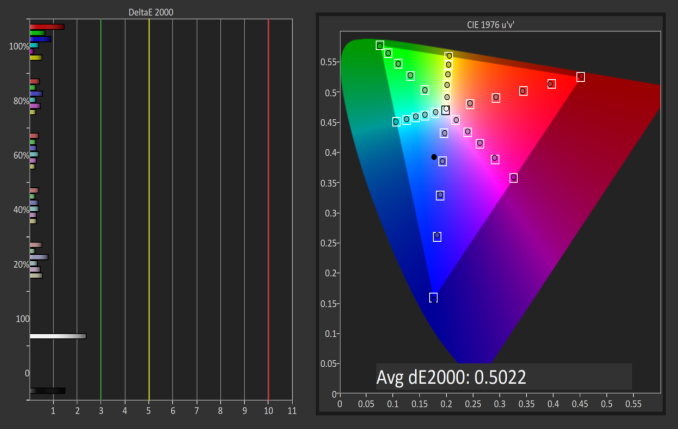
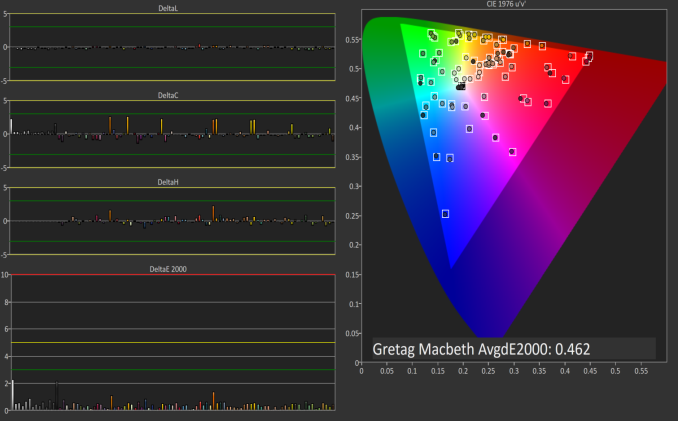
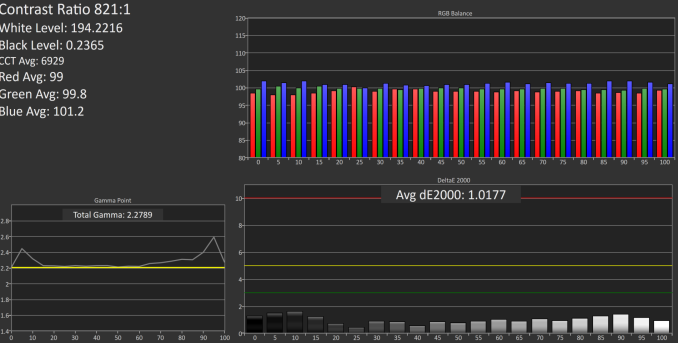
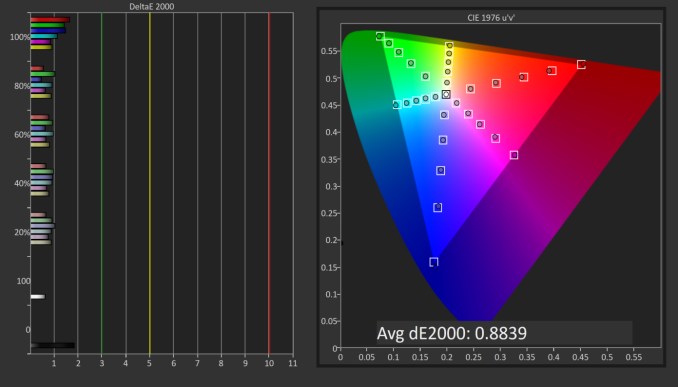

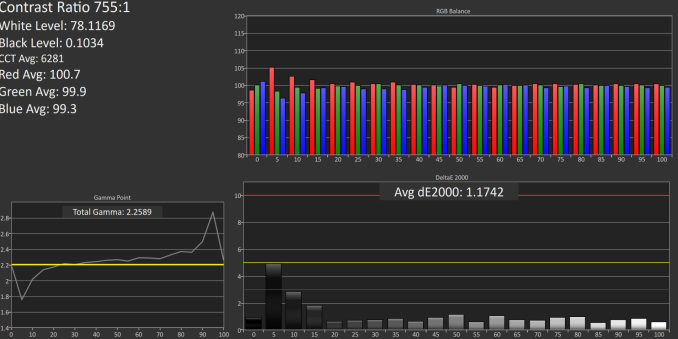











92 Comments
View All Comments
jbrizz - Tuesday, December 22, 2015 - link
I totally agree. There is no point in pushing technology any further beyond this point. In fact, I might take away all but 640k of your RAM, why would anyone need more than that?Spunjji - Tuesday, December 22, 2015 - link
I don't know if you're using Windows 10 or not, but the DPI scaling is getting very good now.hammer256 - Tuesday, December 22, 2015 - link
Frankly, at ~24" viewing distance, 2560x1440 on 27" works pretty excellently for 1:1. I don't want to sit any closer to my monitors, not comfortable for the eyes. If I was going for 4K, I would want something like a 37". Which is huge. And 3 of them? I'll need a bigger desk. I guess with 4K I can make do with just 2 monitors, but once you go triple monitors, you don't go back ;)geok1ng - Thursday, January 7, 2016 - link
Actually, even 32" is way below the confortable reading limit. Most users complain of the PPI on 24" 256x1440 screens, which have a PPI similar to an hypothetical 34" 4k screen. reading at 1:1 4k is impossible for most users even at the 32" monitors. you can not compare with smartphones screens, because the viewing diustance for smartphones is smaller.MatthiasP - Tuesday, December 22, 2015 - link
It's almost double the price of a 4K display, connects via stopgap MST and doesn't bring much improvement in perceived details at arm's length viewing distance over 4K@27".We 4K display owners are still fine, thank you very much.
quickbunnie - Wednesday, December 30, 2015 - link
Problem is, can you even see 5k resolution at 27 inches and a normal viewing distance? You need to be only 21 inches away for a 4k pixel to take up 1 arc minute, nominally considered the limit of average human vision. At this distance, a 27" display takes up 58.5 degrees of you field of vision, which is very large.Even when editing pixel perfect 1:1 4k video, I'm not sure most people will actually be able to see the extra pixels. If you scoot in and look real close, for sure (which I'm sure many professionals do), but I would say 5k does not automatically mean better for most use cases.
LisaValentin3 - Thursday, December 31, 2015 - link
Prima di poter determinare ciò che schermo è giusto per voi, dobbiamo sapere la vostra situazione. Che cosa hai intenzione di utilizzare il portatile per?<a href=http://schermiportatili.it/hp.html>schermo hp</a>
<a href=http://schermiportatili.it/samsung.html>schermo samsung</a>
gonzo98x - Tuesday, December 22, 2015 - link
What's the deal with the price of this monitor when Samsung can squeeze a 4k display into a 6 inch screen and sell it for far less?Doesn't it take a higher level of specialized technology to cram a 4k resolution into such a small display? To me that would mean a phone display should be more expensive or in the case a 27" monitor should cost less.
So where does the cost come from? Or is this simply another example of setting the price for something 'because they can'. We expect it to be expensive so it is expensive?
I'd love to see a teardown and bill of goods for a monitor such as this.
Insert <thesepricesaretoodamnhigh.jpg>
TheStu - Tuesday, December 22, 2015 - link
I imagine it has something to do with the economies of scale. Whoever is making this panel for HP, they're probably looking at less than 100,000 sales (especially if it is NOT the same panel that's in the 27" iMac). Samsung is going to sell tens of millions of their phone displays.bryanlarsen - Tuesday, December 22, 2015 - link
A 6" display has an area of 15 in^2. A 27" display has an area of over 300 in^2. 20x in size, ~20x in cost, where's the disparity?